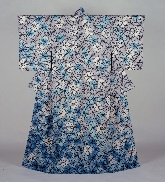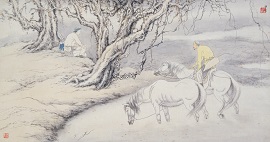Collection GalleryThe 2nd Collection Gallery Exhibition 2015-2016 (135 works in all)
Collection Gallery
HOME > Collection Gallery > The 2nd Collection Gallery Exhibition 2015-2016 (135 works in all)
The 2nd Collection Gallery Exhibition 2015-2016 (135 works in all)
Exhibition Period
6. 6 (Sat.) - 8. 16 (Sun.), 2015
First Period : June 6 (Sat.) - July 12 (Sun.), 2015
Second Period : July 14 (Tue.) - August 16 (Sun.), 2015
Overview
The second collection gallery exhibition of this year features artwork related to our special exhibition on the third floor entitled “Kitaoji Rosanjin: A Revolutionary in the Art of Japanese Cuisine” and the other exhibits associated with this seasonal theme.
Rosanjin once said that “dishware is a kimono for food.” As the title of this special exhibition indicates, the word “dishware” in this case refers to “Japanese dishware.” The exhibits entitled “Crockery in the Picture” explore in turn the relationship between “western dishware” and paintings. In western-style painting traditions, dishware is depicted in religious paintings such as “The Last Supper” and “The Wedding Feast at Cana,” in genre paintings featuring meal scenes of ordinary people, and in still-life paintings. Thus in western art dishware appears either functioning objects in use within the meal scenes, or as “nature morte,” inanimate objects within the still-life paintings. In this section, we explore this contrasting existence of dishware as depicted in painting.
“Dishware is a kimono for food.” Rosanjin’s words can also be interpreted to mean that food should be adorned with dishware. If clothes are the basic elements which separate humans from animals, using dishware to serve and eat food can therefore also be regarded as important behavior which differentiates men from animals. Exhibits which feature man’s intrinsic desire for being dressed are covered in the craft section. Man has always shown a propensity to decorate fabrics and dishware with various ornaments using a variety of techniques and patterns, and then decorate his body and lifestyle with these items. The diversity of this innate desire is being explored in the exhibits centering around the Shibakawa Terukichi Collection. The Kawai Kanjiro section features many excellent works from the period around 1935, when Kanjiro was deeply involved in the Mingei movement, including an award-winning piece which was presented at the Paris Universal Exposition.

Kimono, “Sapphire”, 1964
The key word “decorate” was also passed down to the genre of all-over abstract paintings. As described in the explanation panel in the gallery, non-objective paintings before the war and all-over abstract paintings after the war were created by abstracting traditional, narrative aspects and perspectives (imaginary three dimensionality) in the paintings. The existence of the paintings as two dimensional materials covered with colors and lines, or the state of the paintings which was completely different from conventional paintings were initially criticized as being “decorative.” In this exhibition, such examples have been introduced from our collection.
In the Nihonga (Japanese-style paintings) section, entitled “Japanese-style paintings of Summer Scenes,” paintings featuring early summer scenes and customs, such as “Early Summer Scene in Kamigamo” by Chigusa Soun and "Sweetfish" by Fukuda Heihachiro are being displayed during the first period of the exhibition, and the paintings featuring midsummer scenes and customs, such as “Shower“ by Fudo Ritsuzan and “Summer Garden” by Maruoka Hiroshi, are to be displayed during the second period. A special exhibition commemorating the 70th anniversary after the demise of Hashimoto Kansetsu is also being featured. While being well versed in Chinese classics, Kansetsu also tried to learn from western paintings, based on the traditions of Chinese ancient paintings and techniques of the Shijo School of Paintings. A wide variety of works by Hashimoto Kansetsu, ranging over the whole gamut of his artistic career, are being featured in both the first and the second periods of the exhibition.

Tale of “Mu-ran”, 1920
In the photography section, works by Tomatsu Shomei, who regrettably passed away 3 years ago, are being featured. From his “Mandala” series, which focused on individual localities in his later years, works featuring Nagasaki, Okinawa and Kyoto have been selected for display. Focusing on myriad religious scenes deeply rooted in each locale, Tomatsu has captured the rich ambience of ordinary life, comprising both the past and present, and the sacred and secular, under the contrast of vibrant colors and light. This collection gallery exhibition will coincide with the 70th anniversary of the end of World WarⅡ and will be concluded on August 16, the day of the “Daimonji Bonfire,” a send-off ceremony for the spirits of ancestors, held in Kyoto. It is our sincere wish that this exhibition will give visitors a chance to ponder various matters.
Themes of Exhibition
- ・Crockery in the Picture
- ・70th Anniversary of the Death: HASHIMOTO Kansetsu
- ・Japanese-Style Paintings of Summer Scenes
- ・TOMATSU Shomei: Photographs on Postwar Japan
- ・Crafts must have clothes?
- ・Selected Works of KAWAI Kanjiro from the KAWAKATSU Collection
- ・Allover Paintings in Japanese Postwar Art
- ・[Outside] Outdoor Sculptures
List of Exhibits
The 2nd Collection Gallery Exhibition 2015-2016 (First)
The 2nd Collection Gallery Exhibition 2015-2016 (Second)


